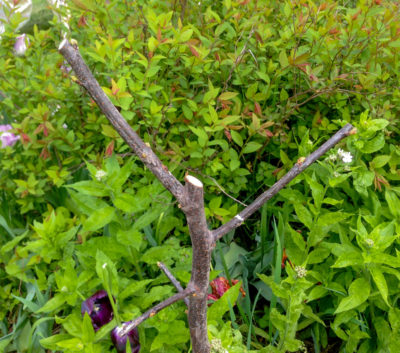PERMACULTURAL GLITCHES
/6 Comments/in Design, Fruit, Gardening, Planning, Pruning/by Lee ReichImperfect Lawn
I’m no devotee of the perfect lawn, but I did recently suggest, for the bare palette of ground on which W wanted to plan for a variety of fruits, a patch of lawn. W protested that she hated mowing and wanted a “permaculture planting” that would take little care.
Visitors to my garden have occasionally complimented me on my lawn. The only care I give it is mowing with a mulching mower that lets clippings rain back down. By not cutting the lawn I avoid “mining” the soil for nutrients by repeated harvest of clippings. The clippings also enrich the ground with humus.

Pawpaw tree in my cousin’s lawn
Still, I’d rather grow trees, shrubs, vines, especially fruiting ones, and vegetables and flowers, than lawngrass. But I have plenty of ground devoted to these plants. And the easiest way to care for a plot of ground, short of sealing it in asphalt or just letting weeds grow (some of which would undoubtedly be edible or attractive) is by mowing. Visually, lawngrass also provide a calm backdrop for the scene out my back and front door. Plus, it’s nice to walk and play on.
A lawn need not be the environmental disaster inadvertently promoted by purveyors of fertilizers, and pesticides. As stated above, by letting clippings fall where they may, ground is not drained of its fertility, so fertilizer may not be needed. Especially if you let a little clover invade the lawn to add nitrogen, the most evanescent of plant nutrients.
That nitrogen highlights another approach to an easier lawn: Not striving for the uniform look of artificial turf. My lawn has its share of dandelions and clover and, later in the season, crabgrass, especially if the weather turns dry. I tolerate all this, with a refocussing of my aesthetic lens to celebrate a certain amount of diversity in the lawn.
Lawn care is even more environmentally sound these days with cordless electric lawnmowers not spewing noise, carbon dioxide, and other byproducts of gasoline consumption into the air. Periodic scything is a very pleasant way to get by with less mowing and sheep may be a way to get by with no mowing (but you do have to fence and do whatever else is necessary to care for the sheep).

Eco-mowers: Fiskars push, Stihl battery, and Scythe Supply Co. mowers
Fruits To (And Not To) Grow
Now for W’s permaculture fruit trees, shrubs, and vines — with some lawn, of course. (I think I convinced her.) For starters, I suggested steering clear of apples, peaches, plums, cherries, nectarines, and apricots. All are relatively high maintenance and, even with all that maintenance, still are iffy crops in this part of the world because of our extreme and variable climate and the plants’ susceptibilities to insects and diseases.

Nanking cherry hedge
So what’s there left to grow??!! Berries, for one. Most berries don’t stand up well to commercial handling so are picked underripe even though they don’t ripen at all once harvested — all the more reason to grow berries in the backyard where the best tasting varieties can be planted and the harvest need not be shipped much further than arms’ length.
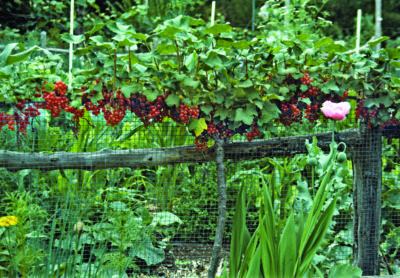
Redcurrant espalier
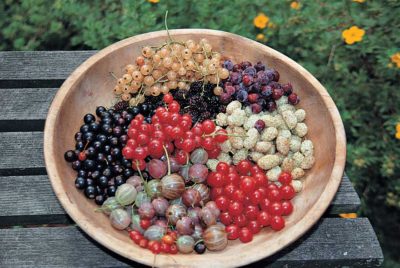
Raspberries, blackberries, blueberries, and strawberries are all easy to grow without much care beyond pruning, which is very important for keeping the plants disease free and convenient to harvest.
And no need to restrict the berry bowl to these most common berries. Also easy to grow are seaberries, elderberries, lingonberries, mulberries, and hardy kiwifruit (which are, botanically, berries). An added plus for these latter berries, as well as the aforementioned blueberries, is that the plants are also ornamental.
There is one common tree fruit that’s easy to grow: pears. And even easier than European pears, such as Bartlett, Anjou, and Bosc, are Asian pears, such as Chojuro, Yoinashi, Hosui, and scores of other varieties. Asian pears also bear more quickly and prolifically, and are a little more decorative than the also decorative European pears.
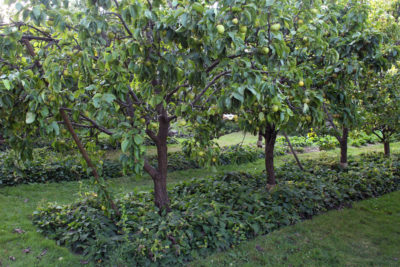
Asian pear, comfrey, and lawn
Avoiding Nightmares
The main problem that I’ve seen with many permaculture plantings is that they look great on paper as well as when first planted. Mouths water at the prospects of all those ornamental, fruiting plants cozied together, fruit on creeping plants beneath trees whose branches strain downward with their weight of fruit. And perhaps a nearby grape or kiwifruit plant insinuating its berried vines in among the trees’ branches.
I’ve seen such plans and such plantings. What a nightmare of management they are or will be, mostly because of the need for relentless, extensive, judicious pruning to keep some plants from overtaking the landscape and starving others for nutrients or light. The result is less fruit of lower quality and difficulty in finding the fruit and getting to it.
A little lawn is good to give the fruiting plants some elbow room and to make them easier to care for.
—————————————-
Don’t wait for dry weather to learn about an easy and better (for you and plants) way to water. On June 24, 1-4:30 pm, I’ll be holding DRIP IRRIGATION WORKSHOP at the garden of Margaret Roach in Copake Falls, NY. Learn how to design a system, and participate in a hands-on installation. For more information and registration, www.leereich.com/workshops.
AWESOME BLOSSOMS & RATIONALITY
/1 Comment/in Flowers, Gardening, Planning, Vegetables/by Lee Reich
Wow!!
With blossoms spent on forsythias, lilacs, fruit trees, and clove currants, spring’s flamboyant flower show had subsided – or so I thought. Pulling into my driveway, I was pleasantly startled by the profusion of orchid-like blossoms on the Chinese yellowhorn tree (Xanthoceras sorbifolium). And I again let out an audible “Wow” as I stepped onto my terrace, when three fat, red blossoms, each the size of a dinner plate, stared back at me from my tree peony.

Both plants originate in Asia. Both plants are easy to grow. Both plants have an unfortunate short bloom period, more or less depending on the weather. Fortunately, both plants also are attractive, though more sedately, even after their blossoms fade.
The tree peonies have such a weird growth habit. I had read that they were very slow to grow so was quite pleased, years ago, when each of the branches on my new plant extended its reach more than a foot by the end of its first growing season. Tree peony is a small shrub; at that rate mine would be full size within a very few years. Or so I imagined.
The tree peony still grows that much every year. But every year many stems also die back about a foot, more following cold winters. No matter, though, because every May giant silky, red flowers unfold from the remaining fat buds along the stem.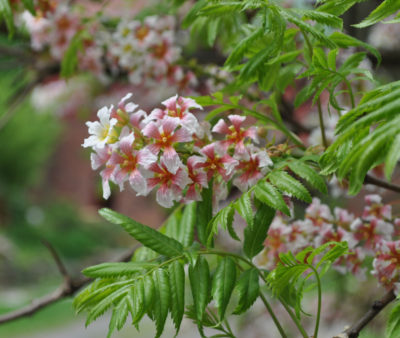
I originally planted Chinese yellowhorn not for its flowers but for the fruits that follow the flowers. Each fruit is a dry capsule that later in summer starts to split open to reveal within a clutch of shiny, brown, macadamia-sized nuts. Yellowhorn frequently makes it onto permaculture plant lists, with the edible nuts billed as having macadamia-like flavor also. Not true. I’ve tried them raw and roasted. Roasting does change the flavor, but raw or roasted, the flavor is bad.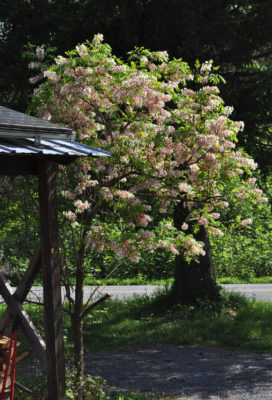
Still, those blossoms make yellowhorn well worth growing. And after the blossoms fade, this small tree is adorned with shiny, lacy leaves. Much like the tree peony, yellowhorn grows many new stems each year, and many of the stems die back, not necessarily from winter cold but because they’re seemingly deciduous. I tidied the tree up last week by pruning off all the dead stems.
Out With You-All
Today, May 25th, with temperatures around 90 degrees F., I may not be able to restrain myself. It’s hard to imagine that temperatures could still plummet below freezing at least one night sometime in the next week or so. I’ve already ignored that “should” and a few days ago moved houseplants outdoors.
Why the rush? First of all, houseplants enjoy growing outdoors more than growing indoors. Outside, breezes rustling leaves and stems make for stronger, stockier growth and rain showering the leaves washes off a winter’s accumulation of dirt and grime.
After a winter indoors, the plants do need to acclimate to these conditions, which is why they start their outdoor vacation on the terrace on the north side of the house, which blocks wind and, for part of the day, sunlight.
I also urged the plants outdoors because populations of aphid and scale insects were outgrowing the appetites of the ladybugs crawling up and down the stems. Outside, natural predators keep pests in check and, if necessary, I can spritz the plants down to knock off pests and spray soap or summer oil to kill them without worrying about getting spray or oil on windows, walls, or furniture.
The Rush On Sweet Corn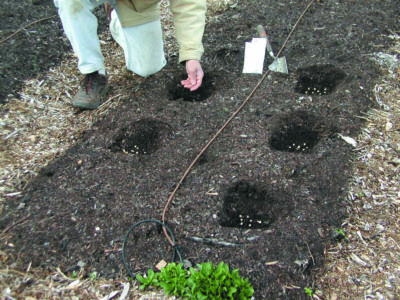
Even tender seeds, such as corn, squash , and beans, can be sown now. The earth has warmed enough for decent germination, and by the time the plants are up, warm weather will have settled in for the season.
Tomorrow I plant sweet corn. Kinky as it sounds, I’m anxious to sink my teeth into a freshly picked ear.
Upcoming Workshop
June 24, 1-4:30 pm, DRIP IRRIGATION WORKSHOP at the garden of Margaret Roach in Copake Falls, NY. Don’t wait for dry weather to learn about this easy and better (for you and plants) way to water, including participation in hands-on installation. For more information and registration, www.leereich.com/workshops.
SANS (fr.) / SIN (sp.) SOIL
/4 Comments/in Gardening/by Lee ReichClarabel And Abbe Fetel
The UPS guy delivered two large, long boxes last week. Laid out in each box as in a coffin was what looked like a sturdy, 4-foot long stick. You wouldn’t think that either stick, one labelled Clarabel quince and the other labelled Abbe Fetal pear, could ever become a tree, could ever even come to life! Unpacking, then holding one of the sticks up, its bare roots dangling in the air, I had my doubts about the plant’s viability, even though I’ve planted many bare root trees over many years.
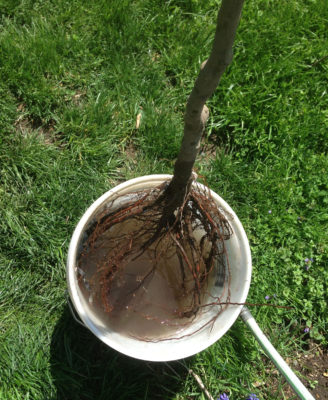
Bare root tree soaking
Bare root trees are grown at a nursery and, sometime between fall and spring while still leafless and dormant, are dug up, their roots shaken free of soil, and shipped. Before shipping a tree, a good nursery will tuck moist sphagnum moss, shredded newspaper, or other water retaining material in among the roots, then swaddle the roots and moist packaging all in plastic.
Some loss of large roots is unavoidable when digging a bare root tree. Less obvious is loss of tender root hairs. And roots don’t ever like being out of the soil. So why didn’t I just order a potted tree, which hardly need know that it’s been moved, rather than a bare root tree?
The main reason for buying a bare root Claribel quince or Abbe Fetel is because there’s not much chance of finding a potted one locally or, probably, anywhere. Bare root trees and shrubs are cheaper to buy and cheaper to mail than potted trees and shrubs, and are available in much greater variety.
Treated well, growth of bare root trees and shrubs will match that of their potted counterparts. Good treatment doesn’t end at the nursery. Soon after unpacking Claribel and Abbe Fetel, their roots were in a bucket of water, to soak for a few hours. Planting holes were dug just deep enough to set each tree at the same depth as at the nursery (as evidenced by the soil line on the trunk) and twice as wide as the spread of the roots. Abbe Fetal had a couple of straggly roots; I clipped them back to the same length as the other roots.
Holding a tree in place with one hand, I sifted soil back in among the spread roots in the planting hole, working the soil in amongst roots by poking with my fingers and occasionally bouncing the plant up and down slightly. After planting, a thorough watering further settled soil in amongst the roots. An icing of mulch — I used wood chips — and the plant, still looking like nothing more than a stick, was ready to go, as far as I was concerned.
Daphne . . . Alive
Last year I bought a potted Daphne bush at a local garden center. As I tipped the plant out of the pot to nestle into its waiting planting hole, all the potting soil fell away from the roots.
It’s not uncommon for a garden center to buy in bare root trees and shrubs, just as I did with Clarabel and Abbe Fetal, then pot them up for sale. Roots in some soil are ready to take in nutrients and water as soon as when warm weather coaxes out new leaves and shoots. Some weeks must pass before the roots actually grow out into the potting soil, though.
The Daphne was leafed out but hardly rooted when I tipped it out of the pot, making it again bare root. I had doubts about its survival. But it did survive. Still, it was an expensive bare-root plant.
Annuals In Cells
A hundred or so years ago, even tender, annual vegetable transplants were re-located to their new homes bare root. Tomatoes would be grown in cold-frames, hot beds, or greenhouses, then gingerly lifted free of the soil. Kept out of the sun and with their roots moist in a bucket of water, the plants were moved to the field or garden and planted, preferably on an overcast day. If the day was dry and sunny, a cedar shingle might be shoved into the ground to shade the plant for a day or two.
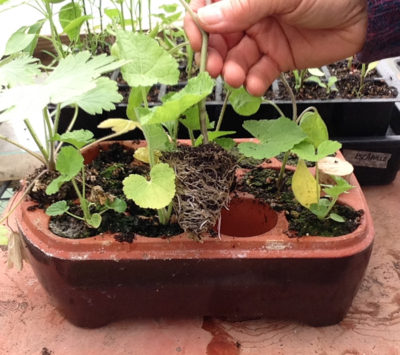
Transplant in Orto pot
These days, as you know, vegetable transplants come in plastic cell packs, each plant in its own mini-pot. For tender, small annual plants, potted is much better than bare-root.
Clarabel Has Risen
Resurrection! Only a few days after planting Clarabel and Abbe Fetel, and, like magic, green buds have swollen along the once dead-looking stems.